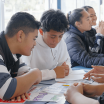Design options for strategy development
Action and Expression guideline
On this page:
On this page:
Current page section: Design options for strategy development
Go to top of current page: Design options for strategy development
Go to top of current page: Design options for strategy development
Go to top of current page: Design options for strategy development
Why this matters
Why this matters
Taking ownership of learning involves setting goals, anticipating challenges, organising resources and monitoring progress.
Offer learners a range of tools and approaches that are accessible and customisable.
Single approaches may create unnecessary challenges and impact engagement and achievement (CAST, 2024).
Design options for strategy development prompts us to reflect on ways to:
This guideline also reminds us to consider:
- How will these options support learners in reaching their goals?
- Could any of these options create barriers or unnecessary challenges?
- Will all learners have fair and equal access to high-quality choices?
- How do these options reflect and respond to learner variability?
Set meaningful goals
Set meaningful goals
Clear, meaningful goals help learners plan, choose the right tools, track progress, and adjust strategies along the way (CAST, 2024).
Anticipate and plan for challenges
Anticipate and plan for challenges
Once a goal is set, provide learners time to plan their strategy and choose helpful tools.
Planning helps reduce barriers and supports motivation and focus (CAST, 2024).
Organise information & resources
Organise information & resources
Working memory acts like a mental “notepad” for holding and using the newest information.
Offer tools where learners can store and organise information (CAST, 2024).
Enhance capacity for monitoring progress
Enhance capacity for monitoring progress
Consider the variability of learners when selecting a range of self-reflection tools and approaches.
Ensure approaches are accessible and customisable (CAST, 2024).
- Use visual tools like before-and-after photos, graphs, or portfolios to help learners see their progress over time.
- Help learners explore and identify which types of feedback are most useful based on their preferences, goals, and learning contexts.
- Offer templates that support self-reflection on the quality and completeness of their work.
- Model different self-assessment strategies, such as role-playing, peer reviews, or video reflections.
- Provide checklists, rubrics, models, and examples to support learners in evaluating their work.
Challenge exclusionary practices
Challenge exclusionary practices
Listen to learners and their whānau about what supports learning and what gets in the way (CAST, 2024).
- Provide regular community, whānau, class or individual reflection sessions to learn about what is working and what is getting in the way.
- Work as individual teachers, teaching teams and as a whole staff to develop concrete and specific actions for addressing exclusionary practices and building inclusive communities.
- When an exclusionary practice is identified, use community-based practices such as restorative practice to guide the restoration process.
- Ensure that all participants in discussions are aware of any actions that are taken.
Source: Challenge exclusionary practices: UDL Guidelines 3.0 | CAST (2024) (opens in a new tab/window)
Next steps
More suggestions for implementing the strategy “Design multiple means of Action and Expression”:
-
Current page Design options for strategy development
Return to the guide “Universal Design for Learning”

How to use this site
Guide to Index of the guide: Universal Design for Learning
Understand:
- Why UDL is valuable
-
Find out about UDLShow suggestions for Find out about UDL
Strategies for action:
-
Design multiple means of EngagementShow suggestions for Design multiple means of Engagement
-
Design multiple means of RepresentationShow suggestions for Design multiple means of Representation
-
Design multiple means of Action and ExpressionShow suggestions for Design multiple means of Action and Expression
- Design options for interaction
- Design options for expression
- Design options for strategy development
-
How to plan using UDLShow suggestions for How to plan using UDL
-
Design considerations in primary settingsShow suggestions for Design considerations in primary settings
-
Design considerations in secondary settingsShow suggestions for Design considerations in secondary settings
-
Design considerations in NCEA assessmentsShow suggestions for Design considerations in NCEA assessments



